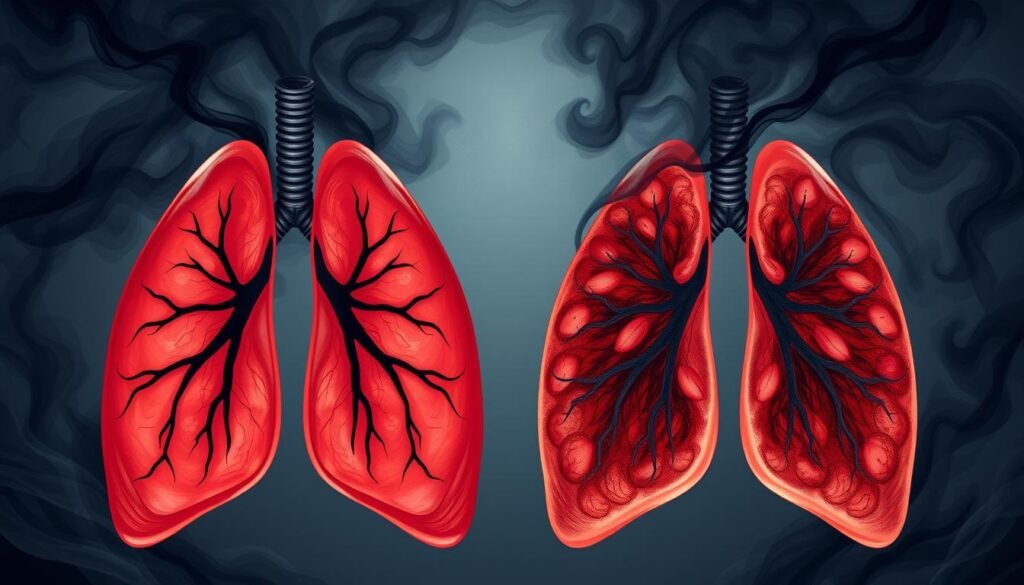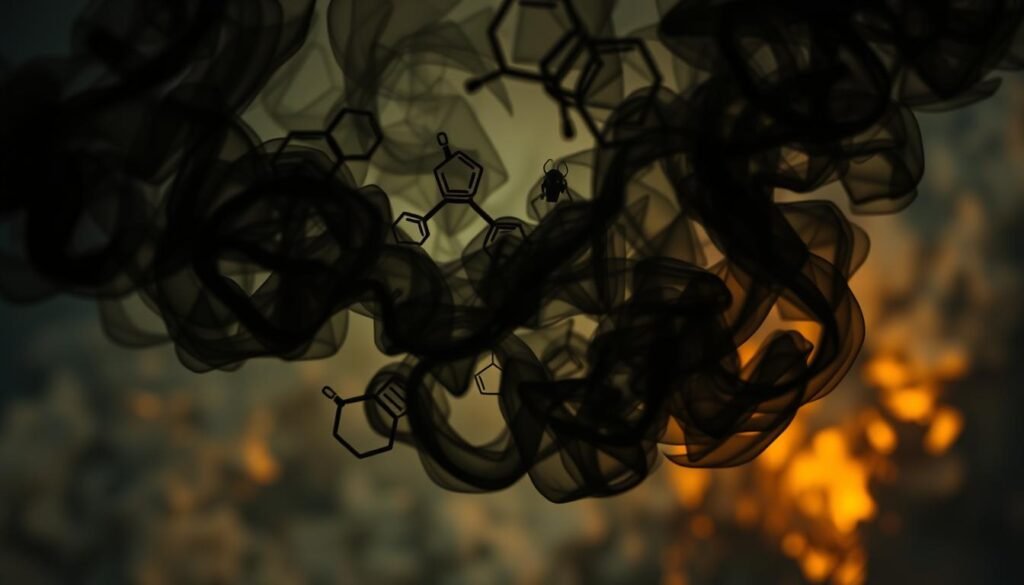Did you know tobacco causes many deaths each year? A shocking 443,000 Americans die too soon because of it. This fact shows we must dig deep into how tar, nicotine, and cancer link together. It’s known that smoking is the main cause of lung cancer, being behind about 90% of the cases. So, what happens in our bodies when we interact with these dangerous substances?
Tar and nicotine are two harmful parts of tobacco smoke. They are not only addictive but also boost cancer growth. Tar, which forms when tobacco burns incompletely, contains over 60 cancer-causing chemicals. These harm lung tissue badly. Nicotine, on the other hand, speeds up tumor growth. It makes the fight against smoking and cancer even tougher. Knowing how they connect is key for public health efforts and quitting smoking effectively.
Understanding how cancer forms because of these substances is crucial. It’s important to spread awareness and educate people on the risks of smoking. Not only does smoking harm individuals, but it also strains healthcare systems. By learning about the dangers, more people might choose to quit. Quitting leads to a healthier life.
Key Takeaways
- Tobacco use leads to approximately 443,000 premature deaths in the U.S. annually.
- Approximately 90% of lung cancer cases can be attributed to smoking.
- Tar contains over 60 known carcinogens contributing to lung damage.
- Nicotine fosters cell growth and reduces the effectiveness of cancer treatments.
- Smoking cessation significantly improves health and reduces cancer risk.
Introduction to Tar and Nicotine
It’s important to know what’s in tobacco to understand its dangers. Tar and nicotine are bad for health. Tar sticks in the lungs and carries many toxic substances. A single cigarette has about 7 milligrams of tar, which can hurt your health over time.
Nicotine, on the other hand, gets people hooked on smoking. It changes how the brain works, leading to addiction quickly. It’s especially harmful for kids’ brain growth.
Smoking anything, like cigarettes or cigars, exposes you to bad stuff. Cigar smoke has really harmful chemicals that can cause cancer. It’s key to understand this to avoid health risks, including more chances of getting cancer.
About 85% of lung cancer comes from smoking, because of tar and nicotine. Tobacco smoke has over 7,000 harmful substances. As smoking habits change, the health risks grow. Learning about these risks at careyourlungs.com helps in making better choices concerning smoking.
Understanding Cancer Development
Cancer development is a complex process. It involves many factors that can cause cell mutation. One major factor is toxins from tobacco smoke.
Tobacco smoke is made up of over 5000 substances. Many of these are known carcinogens. They damage cells and help cancer grow.
Being around tobacco smoke for a long time greatly raises cancer risk. It’s especially true for lung cancer. Up to 85% of lung cancer cases are due to smoking.
The smoke causes specific DNA mutations, known as G-to-T transversions. These are key signs of damage caused by smoking.
Nitrosamines from tobacco can attach to DNA. This leads to wrong DNA copies being made. While nicotine doesn’t directly damage DNA, it makes quitting harder.
It’s very important to lower exposure to tobacco smoke. This helps reduce cancer risk.
https://www.youtube.com/watch?v=gwuwrRK-I2Y
Healthcare providers need to understand how cancer develops. Knowing about cell changes helps in diagnosing and planning treatment. For those looking to learn more, check out this detailed guide.
The Link Between Tar, Nicotine, and Cancer Cells
Exploring how tar, nicotine, and cancer cells connect gives us key insights into cancer. Tar from cigarettes brings many toxic substances into the lungs, causing cell damage. This often leads to abnormal growth of cells, making tar a major cancer risk.
How Tar Contributes to Cancer
Tar is harmful because it has a lot of chemicals. Chemicals like polycyclic aromatic hydrocarbons (PAHs) and N-nitrosamines are very cancer-causing. Smoking even one cigarette exposes the body to 1.4 to 2.2 milligrams of these bad substances.
These chemicals build up and increase the risk of lung and other cancers. Studies, including one from Los Angeles County, show this clearly.
The Role of Nicotine in Cell Mutation
Nicotine also plays a big part in cancer. It helps cancer cells change and spread by supporting Epithelial-Mesenchymal Transition (EMT). This makes it easier for tumor cells to move around the body. Nicotine messes with tumor suppressor genes, like CHK2, which helps cancer grow.
This means we can’t ignore nicotine’s role in cancer. It’s very important we understand how it affects cancer growth.
Tar and nicotine together are a big threat to healthy cells, leading to cancer. Understanding how they work together is key for cancer prevention and quitting smoking. For more details, this link provides in-depth insights on the link between smoking and cancer.
Tar and Lung Cancer: The Direct Connection
It’s key to understand how tar from smoking is linked to lung cancer. Tar is sticky and full of cancer-causing agents. These play a big part in the risk of getting lung cancer.
Smoke from tobacco is very complex and affects the danger of smoking.
The Composition of Tobacco Smoke
Tobacco smoke has over 5,000 different chemicals, including 73 cancer-causers. These chemicals can change DNA and boost the risk of lung cancer. The mix of dangerous tobacco smoke composition and high tar can raise cancer risks. Also, too much tar exposure is bad for breathing and can cause other cancers.
Statistics on Tar Levels and Lung Cancer Risk
Numbers show a scary link between tar levels and lung cancer risk. Each year, lung cancer kills over 1 million people around the world. Smoking is a huge risk factor, causing 90% of lung cancer in men and 70-80% in women.
Smokers are 30 times more likely to get lung cancer than non-smokers. Lung cancer deaths outnumber those from prostate, colon, pancreatic, and breast cancers combined. This highlights how dangerous tar and tobacco smoke are.
| Statistic | Value |
|---|---|
| Lung cancer deaths worldwide annually | Over 1 million |
| Percentage of lung cancer risk attributable to smoking in men | 90% |
| Percentage of lung cancer risk attributable to smoking in women | 70-80% |
| Increased cancer risk for smokers compared to nonsmokers | 30-fold |
| Survival rate at 5 years for lung cancer patients | 15% |
| Survival rate at 1 year for lung cancer patients | 42% |
| % of all cancer deaths in men due to lung cancer | 31% |
| % of all cancer deaths in women due to lung cancer | 26% |

Nicotine Addiction and Its Implications
Nicotine addiction makes quitting smoking tough. This substance changes the brain’s reward system, causing strong dependence. It’s vital to understand this dependence to effectively tackle smoking.
How Nicotine Creates Dependence
Nicotine quickly reaches the brain when inhaled, releasing dopamine. This leads to pleasure, causing a cycle of craving and reward. Genetics also affect nicotine addiction. For instance, the α4β2* receptor type is crucial in this addiction. Withdrawal from nicotine may cause anxiety and stress, making quitting harder.
Long-term Effects of Nicotine on Health
Nicotine’s health impacts are serious. Smokers face a higher risk of early death compared to non-smokers. In the U.S., smoking causes about 480,000 deaths yearly, many from cancer. Secondhand smoke increases a non-smoker’s lung cancer risk by 20-30%. Nicotine use over time can lead to heart disease and impact cancer treatment, since it can encourage cell growth and block tumor suppressors.
| Statistic | Value |
|---|---|
| Smokers who relapse within the first month | 80% |
| Smokers who remain abstinent at six months | 3% |
| Annual deaths in the U.S. due to cigarette smoking | 480,000 |
| Lung cancer deaths among non-smokers due to secondhand smoke | 7,300 |
| Increased lung cancer risk for non-smokers living with smokers | 20-30% |
Carcinogens in Tobacco Smoke
Tobacco smoke is made up of many chemicals, with a lot being carcinogens. Knowing the critical compounds helps us understand how they cause cancer. Over 70 out of more than 7,000 chemicals in cigarette smoke are cancer-causing.
Identifying Key Carcinogenic Compounds
Some carcinogens in tobacco smoke are more harmful due to their strong link to cancer. Important ones include:
- Benzo[a]pyrene (BP): This is a well-researched chemical that damages DNA and leads to mutations.
- Nitrosamines: They come from nicotine and can mess up how DNA copies itself.
- 4-aminobiphenyl: Found more in the smoke that drifts away than in the smoke inhaled, known for being highly carcinogenic.
Smoking commonly causes cancer in the lungs, mouth, and bladder. This is because of the harmful chemicals in tobacco. How much you smoke and for how long plays a big role in cancer risk. It notably causes most lung cancer cases among smokers.
The Mechanisms Through Which Carcinogens Trigger Cancer
Carcinogens cause cancer by directly interacting with cells. For example, tobacco chemicals can bind to DNA. This leads to mutations known as the “smoking signature,” including changes from G to T.
The cancer-causing process also includes steps like:
- Absorbing carcinogens.
- Turning them into forms that damage DNA.
- Avoiding DNA repair.
- Attacking key cellular genes.
- Causing mutations in organs that lead to cancer.

Cigarette smoking causes about 85% of lung cancer cases. It also leads to many other types of cancer. Understanding how these carcinogens damage cells is crucial in grasping their role in cancer development.
Cell Mutations Induced by Tar and Nicotine
Tar and nicotine deeply affect cells, leading to major genetic changes. It’s important to understand how they help cancer grow. One key process is the Epithelial-Mesenchymal Transition (EMT). This makes normal cells turn into ones that can invade other tissues. It’s a big focus in cancer research because of its role in many cancers.
The Process of Epithelial-Mesenchymal Transition (EMT)
The EMT process makes cells move and spread, which is crucial for cancer to spread. Tar damages cells and messes up their normal signals. When cells are exposed to cigarette smoke, it impacts proteins that control cell growth. This can make cells grow uncontrollably and spread tumors.
Impact on Tumor Suppressor Genes
Nicotine messes with genes that prevent tumors, making cancer more complex. It stops signals that control cell death, leading to unchecked growth. For example, smoking changes important genes for cell death and growth. This shows how crucial these substances are in cancer, through genetic and biochemical ways.
Strategies for Smoking Cessation
Quitting smoking is tough for many people. The right strategies can make it easier to succeed. There are various methods and support to help those wanting to quit. Knowing these methods is important for a smoke-free life.
Effective Methods to Quit Smoking
There are many strategies to quit smoking. Each one has its own benefits. Using Nicotine Replacement Therapy can really help compared to quitting all at once. Here are some effective methods:
- Nicotine Replacement Therapy: Patches, gum, and lozenges give a controlled amount of nicotine. This helps reduce withdrawal symptoms.
- Gradual Reduction: Smoking fewer cigarettes each day can make it easier to quit. But this method might not be very healthy on its own.
- Counseling and Support Groups: A supportive community or counselor can give the motivation needed to quit.
- Mindfulness Techniques: Yoga and meditation can help with cravings. However, how well they work can differ from person to person.
- Non-Invasive Brain Stimulation: This is still being researched but has helped some people quit.
Support Resources for Quitting
Support is very important when quitting. There are many resources available to help and encourage people. These include:
- National Quitline: A free resource that offers advice and support based on your needs.
- Community Support Groups: Local groups offer meetings and workshops to help you quit.
- Mobile Applications: Apps that track your smoking habits, give tips, and motivate you.
- Online Forums: Online communities where people share their experiences and strategies, making you feel part of a group.

Quitting smoking is about making informed choices and finding support. Using the right strategies can greatly improve your chances of quitting for good. Committing to quit is good for your health and the health of those around you.
| Method | Effectiveness | Notes |
|---|---|---|
| Nicotine Replacement Therapy | High | Significantly increases chances of success. |
| Gradual Reduction | Moderate | May help reduce withdrawal symptoms. |
| Counseling and Support Groups | High | Provides motivation and community support. |
| Mindfulness Techniques | Variable | Can lower cravings; effectiveness varies. |
| Non-Invasive Brain Stimulation | Promising | Still under research for effectiveness. |
Cancer Prevention Through Awareness
Public Health Campaigns are key in raising Smoking Awareness. They teach people about the dangers of smoking. Every year, tobacco claims over 480,000 lives. The campaigns explain the risks, like many types of cancer.
Public Health Campaigns Against Smoking
These initiatives use different methods to fight tobacco. They include:
- Ads that highlight smoking dangers.
- Programs in schools that teach about tobacco’s health effects.
- Events that stress the importance of stopping and preventing smoking.
They tackle myths about “light” cigarettes being safer. Smokers of these cigarettes tend to smoke more. They think they’re less harmful, but they’re not.
Community Support and Education Efforts
Communities are vital in Cancer Prevention. Many groups work together to improve awareness and offer resources. These include:
- Groups that support quitting in a positive atmosphere.
- Workshops on the health risks of smoking and quitting benefits.
- Partnerships for educational materials and counseling.
Public Health Campaigns and community support are crucial. Together, they help reduce smoking and increase awareness of tobacco risks. With everyone working together, we can make a healthier society a reality.
| Smoking-Related Risks | Statistics |
|---|---|
| Annual tobacco-related deaths | Over 480,000 |
| Cancers linked to tobacco | Lung, mouth, esophageal, and more |
| Percentage of cancers related to tobacco (men) | 25% |
| Percentage of cancers related to tobacco (women) | 4% |
Conclusion
It’s crucial to grasp how tar, nicotine, and cancer are linked to deal with smoking dangers. About 2.4 million tobacco-related cancer cases were found from 1999 to 2004. This shows how serious exposure to cigarette smoke is. Even though tar and nicotine levels have dropped, the health risks are still big. For instance, 30% of cancer deaths are linked to tobacco. This shows why we must keep teaching people about the dangers of smoking.
Recent research shows that low-tar cigarettes lead to changed smoking habits, raising health risks. Smokers inhale more deeply to get the same nicotine hit. This hasn’t reduced lung cancer risks as hoped. We need to address how tobacco use is changing. This will help educate the public and support quitting efforts. It’s key to see the harmful ties between these substances and health.
It’s crucial for everyone to work towards a healthier future. Knowing the link between tar, nicotine, and cancer helps make better choices. Public health efforts are also important to cut down tobacco use. For more details on how cigarette design changes affect health, check out this comprehensive study. Educating people can lead to healthier lives and fewer tobacco-related illnesses.